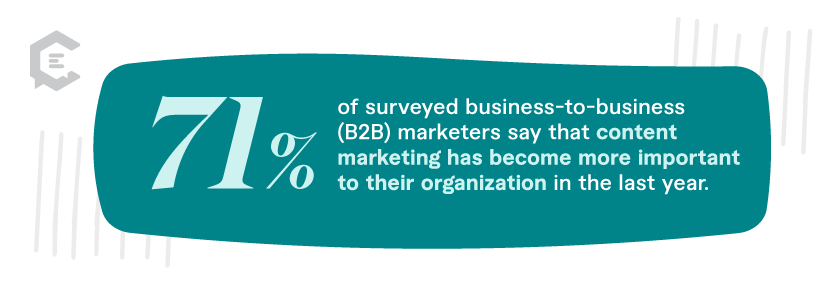As online audiences consume massive amounts of content daily, more business-to-business (B2B) marketers recognize the power of content marketing to connect with customers.
But building an audience through content is always challenging, even for large businesses with lots of resources. Their size can create unique challenges in their content marketing campaigns.
This comprehensive guide will detail those B2B content marketing challenges while offering actionable strategies to overcome them and enhance your content marketing strategy.
The Top Challenges in B2B Content Marketing for Large Companies
According to a 2023 Content Marketing Institute research report, 71 percent of B2B marketers say that content marketing has become more critical to their organization in the last year. However, large companies must contend with complex organizational structures and buyer committees.
If you’re part of a large brand, there are some things to watch out for. First, we’ll cover the top three challenges B2B content marketers face, and then we’ll offer two bonus challenges to anticipate for your business.
Challenge 1: Producing High-Quality Content Consistently
High-quality B2B content shares compelling stories and case studies about how your business’s product or service solved a customer’s problem. Good content offers insights that change a reader’s thoughts about a business issue. It may even offer surprising and inspiring ideas for how to solve a business-related problem.
High-value content is challenging to produce and even harder to create regularly. Nevertheless, offering your audience consistent, high-quality content maintains audience engagement, improves your visibility on search engines, and builds a trustworthy brand for your company.
Overcoming the Challenge
- Tap into customer feedback and data analytics to discover the issues that matter most to your audience and create content to address their most important needs.
- Develop a comprehensive content calendar with a strategic content creation and distribution framework. That allows you to plan for the type of content you need to produce months in advance, making regular quality content more feasible.
Challenge 2: Scaling Content Production
From reports to e-books to infographics and podcasts, the amount of content produced by large B2B companies is pretty sizable. This scale of content production doesn’t simply mean producing more content but also involves maintaining the balance between quality and quantity.
Overcoming the Challenge
- Outsource content creation to content agencies or freelancers to ease the strain of producing multiple types of content and targeting multiple markets completely in-house.
- Make your in-house team responsible for maintaining your company’s brand voice in this new content to sustain quality as you scale up your content production.
Challenge 3: Measuring Content Marketing ROI
While content marketing boosts conversions and increases brand recognition, these benefits often materialize over the long term. That makes it difficult to measure your content marketing strategy’s return on investment (ROI) in the short run and determine which types of content produce the best results.
Overcoming the Challenge
- Align your content marketing goals with your overarching business objectives.
- Use advanced analytics tools to track macro (sales) and micro (social shares, likes) conversions.
- Map out the customer journey to identify which content pieces drive conversions and where your potential customers may drop off. Such tactics help you determine which pieces of B2B content produce positive results and which still need improvement.
Bonus Challenge #1: Maintaining Consistent Messaging Across Departments
Maintaining a consistent brand voice can be tricky as you scale your content production. An enterprise content strategy must address an often complicated internal organizational structure to align business units with different objectives and audiences.
When each department creates and distributes its content in an ad hoc manner, you risk delivering an inconsistent and disjointed customer experience that fails to progress prospects down the sales funnel effectively.
Overcoming the Challenge
- Create a centralized content hub or platform where all your content is stored, reviewed, and approved. That ensures alignment across the board for everyone.
- Cross-departmental communication is essential for any large company. Hold regular inter-departmental meetings to discuss strategies, campaigns, and messaging. That’ll shore up any gaps in communication and make sure everyone’s on the same page.
- Develop a comprehensive brand style guide that covers everything from brand voice, tone, design aesthetics, and key messaging. That’ll ensure everyone adheres to the same standards.
Bonus Challenge #2: Managing Complex Sales Cycles
A B2B SaaS content strategy must address the unique dynamics of B2B purchasing. The long sales cycle means you must keep the audience engaged for months (or even years.) The timeline also makes it more difficult to track the effectiveness of your campaign and make timely adjustments. Plus, you must navigate non-linear decision-making processes involving multiple stakeholders with different concerns and priorities.
Overcoming the Challenge
- Implement lead nurturing campaigns that periodically send relevant, engaging content to prospects. An automated email sequence can keep your brand at the top of your audience’s mind over a prolonged sales cycle.
- Adopt a multi-touch attribution model to better understand which content and touchpoints drive conversions at different stages of the buyer’s journey.
Case Studies: Enterprises That Mastered These Challenges
Some of the most well-known B2B companies have overcome content marketing challenges by focusing on their audience’s wants and needs. Let’s dive into some examples.
IBM Content Strategy and Results
Listen to IBM’s Wild Ducks podcast, and you’ll hear stories about how creative uses of technology are helping to improve everything from business practices to medical diagnoses.
What’s great about this approach is that the podcast spotlights the schools, companies, and institutions helping other businesses through their innovations instead of making their episodes all about IBM technology.
That motivates these companies to link to the podcast because by promoting IBM, and they’re also promoting their own brand. For instance, UNC Lineberger Comprehensive Cancer Center ran a story on how IBM’s super-computer Watson is being used to help treat people with cancer. Likewise, Certus Digital mentions a Wild Ducks episode covering advancements in digital banking. By putting their good work first, everyone gets to raise awareness of their brand.
General Electric Strategy and Results
Take a look through General Electric’s (GE) daily online media portal, GE Reports, and you might find a story on how Australia’s hydrogen power plants are helping to decarbonize the country. Or how a personalized pancreatic cancer vaccine is helping to stave off tumor regrowth. Or how the next generation of robots could be programmed to help people with dementia find misplaced items.
What do all these stories have in common?
They focus on telling stories about the technology rather than promoting the GE brand. By doing so, they’ve managed to engage their target audience and built a following of over 100,000 subscribers and 3.7 million monthly visits in 2021. Some of its content has also gone viral on Reddit multiple times, increasing its reach and building GE’s brand as a trustworthy source of valuable information.
Practical Strategies to Overcome B2B Content Marketing Challenges
How can you make sure your own content produces results like those listed above? Keep the following strategies in mind:
Define clear goals
Ensure everyone on your team understands what you want to accomplish with your content marketing.
Do you want to:
- Nurture leads?
- Enhance brand awareness?
- Improve customer engagement?
Accomplishing any of these goals informs how you develop and promote your content. For example, improving customer engagement while enhancing brand awareness might mean not mentioning your company in every content piece. Instead, focus on telling intriguing stories and getting people to share them on Reddit or Quorra. Doing that will increase the number of links leading back to your website and create a more sharable brand.
Know your audience
Creating buyer personas based on what you believe your audience needs and wants is a good first step, but don’t stop there. Contact your clients and ask them for feedback on what they’d like to read and learn about in your content. The less you speculate and the more you base your content creation decisions on facts about your audience, the better content you’ll produce.
B2B sales cycles are complex — you can’t just throw spaghetti on the wall and hope something will stick. Identify all the buyer personas involved in decision-making to set a solid foundation. It will inform your B2B content strategy and help you focus on the right KPIs to stay on track.
Embrace data
Analytics tools reveal how your audience responds to your content. Study the data to learn:
- How much time visitors spend reading your blog posts or listening to your podcasts
- What type of content leads to more conversions
- What CTAs in your A/B testing to see if certain CTAs perform the best
By analyzing the patterns this data reveals, you’ll gain essential insights into your audience’s behavior. From there, you can continue promoting the content readers prefer while revising strategies with a poor ROI, ensuring you use your resources wisely.
Align your messaging
Develop and execute your B2B content strategy with a centralized content marketing team. It should collaborate with each department and align all content with the company’s messaging goals. It should also create and distribute a style guide to support consistent communications from each business unit.
Set up a centralized content repository so different departments can search for sales and marketing materials instead of reinventing the wheel. Educate employees about the importance of using consistent content and ensure they understand how to create consistent customer communications.
Track indirect benefits and ROI
Use direct and indirect metrics to gauge the success of your enterprise content strategy. For example, ask customers via surveys or interviews how they learned about your brand or what content they find most helpful. You should also track engagement on social media, such as sharing, liking, and commenting.
Additionally, you can gauge the effectiveness of your B2B content strategy by tracking overall business metrics, such as website traffic, leads, and sales. If the numbers improve after you have started publishing content or launched a specific campaign, the strategy is likely to have created a positive impact.
Optimize Your B2B Content Marketing for Success
Ultimately, the future of B2B content marketing is not about creating more content; it’s about creating the right content. This is particularly relevant for large enterprises that need to regularly produce high-quality content that increases their brand awareness and conversions without depleting their resources.
If you’re looking for help navigating your B2B content marketing challenges, ClearVoice has your back. Get started with ClearVoice today and find the right content creators to ensure your B2B content strategy drives your brand’s growth and success.









